

Pietro di Puccio, who came from Orvieto, worked on the Cappella del Corporale of the Duomo under Ugolino di Prete Ilario in 1362 -64. In 1365, he was documented at Milan, in the service of Gian Galeazzo Visconti. In 1389-91, he painted frescoes of scenes from Genesis at the Camposanto, Pisa, but these were destroyed in the bombardment of the Second World War.
Orvieto
Frescoes of Cappella del Corporale (1357-64)
The frescoes of the Cappella del Corporale were commissioned in 1356 from Giovanni di Buccio Leonardelli and Ugolino di Prete Ilario. The first of these artists soon left the team to concentrate on the mosaics of the facade. Ugolino di Prete Ilario continued the work with the assistance of a number of other local artists, including Pietro di Puccio. He signed one of the frescoes on the back wall as ugolino, painter of Orvieto, and dated it very precisely to 8th June 1364, which was presumably the date of completion of the entire programme of decoration. Many of the scenes have Latin explanatory inscriptions (1362) devised by “Ser Checco di Pietro”.
Unfortunately, the frescoes were poorly restored in the 19th century. Some of the original sinopie were discovered during the restoration of 1975-8. They were detached at that time and are now in the Museo dell' Opera del Duomo.
Scenes from the Passion
The frescoes on the back wall depict:
-
✴the Crucifixion;
-
✴the Last Supper; and
-
✴the Resurrection.
Miracle of Bolsena
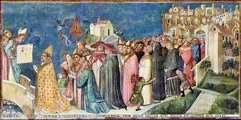
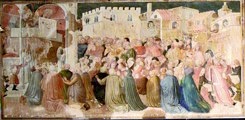
Urban IV greats the Bishop of Orvieto Urban IV shows the Sacro Corporale to the people
at the bridge over the Rio Chiaro as he returns of Orvieto from the loggia of Palazzo Papali
from Bolsena with the Sacra Corporale
The eight frescoes on the right wall of the altar bay depict scenes from the events surrounding the miracle of Bolsena.
Eucharistic scenes
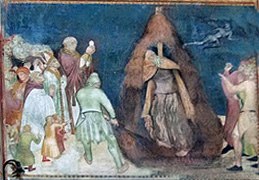

A priest drives the devil from a condemned A Jewish man burns his son,
heretic by elevating the consecrated Host who has eaten the consecrated Host.
[Where in the entrance bay ??] In a later scene, the Virgin intervenes and
the boy is safely removed from the flames
(Left wall of the altar bay)
Many of the other frescoes in the chapel provide graphic details of the power of the consecrated Host and the unhappy fate of people who fail to venerated it.
Mosaics on Facade of the Duomo
Pietro di Puccio is recorded as a mosaicist working of the facade of the Duomo from the 1370s. He was appointed as magister mosaici in1380. He is specifically documented in relation to the following mosaics for of the Duomo:
Presentation of the Virgin (1376)
The original mosaic in the right upper cusp bore the signature of Pietro di Puccio and the date 1376.
Marriage of the Virgin (1612)
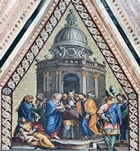
Doctors of the Church (1388)
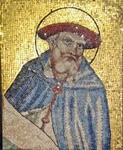
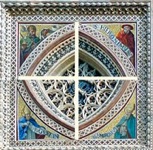
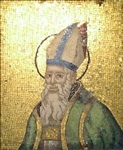
St Jerome Present replacement St Ambrose
Pietro di Puccio was recorded as working on the original frescoes that surround the rose window. They were detached and replaced by copies in the 19th century. Fragments depicting SS Jerome and Ambrose survive in the Museo dell' Opera del Duomo.
Scenes from the life of St Matthew (late 14th century)
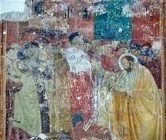
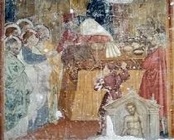
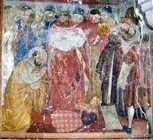
These frescoes of three scenes from the life of St Matthew on the back wall of the Cappella di San Matteo in San Francesco are attributed to Pietro di Puccio. They depict:
-
✴the calling of St Matthew (a composition that is important for its precocious attempt at perspective and the last for the realism of the expressions); and
-
✴two stories from the Golden legend of Jacobus de Varagine:
-
•St Matthew disables two dragons in Ethiopia by making the sign of the Cross and, commanding, according to the inscription, "In the name of God, go and leave the people in peace"; and
-
•St Matthew resuscitates the son of King Egippus of Ethiopia, an event that led to the king’s conversion and inspired the formation of the Coptic church.

Frescoes (late 14th century) in San Giovenale
The frescoes in San Giovenale that are attributed to Pietro di Puccio include:
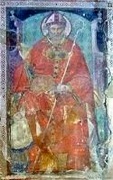
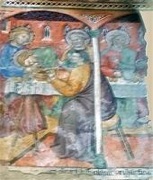
-
✴two on the counter-facade:
-
•St Juvenal enthroned with donor, to the right of the portal (and of the small door that leads to the campanile); and
-
•the Last Supper, at the extreme right (on what is actually the right wall of the baptistery on the left wall); and

-
✴a fresco in the 2nd bay of the left wall, of which only the upper part of survives, which depicts:
-
•St William of Malavalle (holding a rosary and carrying the Rule of his Order);
-
•St John the Baptist;
-
•St Juvenal; and
-
•St Lawrence (with the grill on which he was martyred).
Madonna and Child with saints (late 14th century)
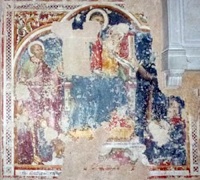
This damaged fresco in Sant’ Andrea (in the 2nd bay of the left transept) is attributed to Pietro di Puccio. It depicts Madonna and Child with SS Antony Abbot and Mark and a donor.
Perugia
Fresco Fragment (1398)
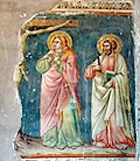
Read more:
C. Fratini, “Pittura e Miniatura ad Orvieto dal XII al XIV Secolo”, in
G. della Fina and C. Fratini (Eds), “Storia di Orvieto: Medioevo”, (2007) Pisa, pp. 491-3
C. Fratini, “Un Ciclo Inedito di Pietro di Puccio in San Francesco di Orvieto”, in
A. De Marchi (Ed.), “Intorno a Gentile da Fabriano e a Lorenzo Monaco: Nuovi Studi sulla Pittura Tardogotica” (2008) Livorno, pp 187-98
M. Boskovits, “Pittura Umbra e Marchigiana fra Medioevo e Rinascimento: Studi nella Galleria Nazionale di Perugia”, (1973) Florence. The attribution of the fresco in Sant’ Agostino, Perugia is discussed at pp 21-2 and Figure 65.

